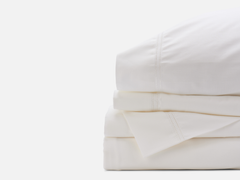there is a large and important conversation happening among consumers today.
We are starting to ask questions about where our products come from, how they are made and the effects of both the products and their manufacturing process on ourselves and the environment. These are questions that deserve answers so that we as consumers can make informed decisions for ourselves and our families. A lot of these questions revolve around the topic of GMO seed and chemical use in crop production. While these conversations are valid and we should have them, it is also important to look beyond the field and take note of the fibers that fall outside of the “organic” conversation.
SYNTHETIC FIBERS
Synthetic fibers have risen in popularity and production due to low production cost and the many “benefits” these fibers possess. But let’s talk about why it is so “cheap” and what “cost” we may actually be paying for the convenience of synthetics.
Polyester is the most popular of the synthetic man-made fiber, and it is easy to see why. It is durable, doesn’t shrink and is fairly resistant to wrinkles. It plays easily into our fast paced culture because it doesn’t need any extra care or consideration. But let’s face a very scary reality, this wonder fiber is made from oil. It is made by combining two oil-derived products: PTA (purified terephthalic acid) and MEG (mono ethylene glycol - which is also used in antifreeze). Melting and spinning produces polyester fiber, otherwise known as PET (polyethylene terephthalate).
PET is the same material used to make plastic bottles which explains polyester’s durability. Oil accounts for around 50% of the cost of PET. Therefore, polyester pricing is correlated to the oil price. With oil prices being much lower than they have been in years and every manufacturer trying to reduce cost in any way — why wouldn’t they use a polyester fiber over a much more costly natural fiber like cotton?
well if the thought of wearing petroleum next to our skin doesn’t concern us, maybe we should look at some other properties of polyester.
-
It’s not biodegradable. It does not decompose well, and if left in a landfill, it will continue to sit there.
-
It doesn’t allow for airflow between our skin and the outside world so it’s fairly suffocating to our largest organ.
-
It melts at high temperatures (so watch the iron if you have to use it).
-
It’s tightly woven fibers make it difficult to remove odors. That’s right. The stuff can make us smell.
This synthetic fiber hides in a lot of home linens for obvious reasons. It’s blended with cotton to make the resulting fabric resistant to stains and wrinkling. Cotton allows it to be tolerable to the touch. It lends its plastic quality to natural fibers to increase their durability and strength. And it’s cheap to produce … so in the world of fast fashion and ever changing home decor trends — why not use polyester?
fortunately, we get to choose what we sleep on, what cleans our bodies and what linens set our tables.
For us, it’s an easy choice. We believe cotton is not only a more safe and natural choice but also one that makes sense for home linens. It allows for a better night’s sleep because it’s breathable and wicks sweat away. It’s soft but strong. No, it won’t be as durable as the synthetic competitor, but with the proper care and consideration, cotton can last generations. Most importantly, when finished with minimal chemicals, cotton is hypoallergenic. When we’re at home, we seek comfort, relaxation and peace. We deserve to be wrapped in soft, breathable and natural fibers that feel good, look good and are good for us and the environment.
We have made it part of our mission to educate and inform. This is only one topic that deserves to be discussed when looking at the whole of the market and choosing what we want to touch our bodies. We respect this discussion and hope to add value to the conversation.
Thanks for stopping by!
All opinions are our own.
Information sourced from http://www.huffingtonpost.co.uk/heidy-rehman/are-your-clothes-making-you-smell_b_10319164.html









